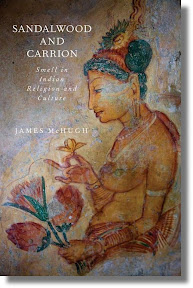Sandalwood and Carrion
McHugh, James:
Sandalwood and Carrion : Smell in Indian Religion and Culture / James McHugh. - New York : Oxford University Press, 2012. - ca. 352 S.
Hochschulschrift. Teilw. zugl.: Cambridge, Mass., Harvard Univ., Diss., 2008
ISBN 978-0-19-991630-6
US$ 99,00 (Hardcover)
ISBN 978-0-19-991632-0
US$ 35,00 (Paperback)
DDC: 152.1660954
-- Angekündigt für September 2012 --
Beschreibung
James McHugh offers the first comprehensive examination of the concepts and practices related to smell in pre-modern India. Drawing on a wide range of textual sources, from poetry to medical texts, he shows the significant religious and cultural role of smell in India throughout the first millennium CE.
McHugh describes the arts of perfumery developed in royal courts, temples, and monasteries, which were connected to a trade in exotic aromatics. Through their transformative nature, perfumes played an important part in every aspect of Indian life from seduction to diplomacy and religion. The aesthetics of smell dictated many of the materials, practices, and ceremonies associated with India's religious culture. McHugh shows how religious discourses on the purpose of life emphasized the pleasures of the senses, including olfactory experience, as valid ends in themselves. Fragrances and stenches were analogous to certain values, aesthetic or ethical, and in a system where karmic results often had a sensory impact-where evil literally stank-the ethical and aesthetic became difficult to distinguish. Through the study of smell, McHugh strengthens our understanding of the vital connection between the theological and the physical world.
Sandalwood and Carrion explores smell in pre-modern India from many perspectives, covering such topics as philosophical accounts of smell perception, odors in literature, the history of perfumery in India, the significance of sandalwood in Buddhism, and the divine offering of perfume to the gods. [Verlagsinformation]
Inhalt
Preface. ix
Acknowledgments. xvii
Part I: Smells in Theory
1. Introduction. 3
2. Earth, Wind, Foul and Fragrant: The Theory of Smelling and Odors in Early South Asia. 20
Part II: Smells in the World
3. Lotus, Fish, and Cows: The Smellscape of Traditional South Asia. 61
4. Flowers and Fish in the Mahābhārata. 91
Part III: Smells in Practice
5. Moon Juice and Uproar: Perfumery Texts. 105
6. Allies, Enemies, and Yakṣa Mud: Perfumes. 135
Part IV: Aromatic Materials
7. The Incense Trees of the Land of Emeralds: Exotic Aromatics in Medieval South Asia. 159
8. Sandalwood: Merchants, Expertise, and Profit. 180
Part V: Smell and Religion
9. Bois des Îles. 203
10. The Toilette of the Gods. 218
Epilogue. 244
Appendix: Sanskrit and Prakrit Texts on Perfume Blending and Perfumery. 249
Notes. 253
Bibliography. 295
Index. 313
Autor
James McHugh studied philosophy at the University of Cambridge before becoming interested in the study of Sanskrit and religion in India. After pursuing a master's degree in Indian religions at the University of Oxford, he received a Ph.D. from Harvard, researching the history of smell and perfumery in pre-modern India. He is Assistant Professor of Religion, University of Southern California. Profile page.
Quellen: Oxford University Press (USA); WorldCat; Amazon; Google Books; Library of Congress
Bibliographie: [1]
References
Ähnlich
- Religion, Science, and Empire
- Narrative Pattern and Genre in Hagiographic Life Writing
- Appleton: Narrating Karma and Rebirth
- Veer: The Modern Spirit of Asia
- Puspika 2
- Puspika 1
- Hindu, Buddhist and Daoist Meditation
- Jeremiah: Community and Worldview among Paraiyars of South India
- Scriptural Authority, Reason and Action
- Weber: Religion und Religionskultur

